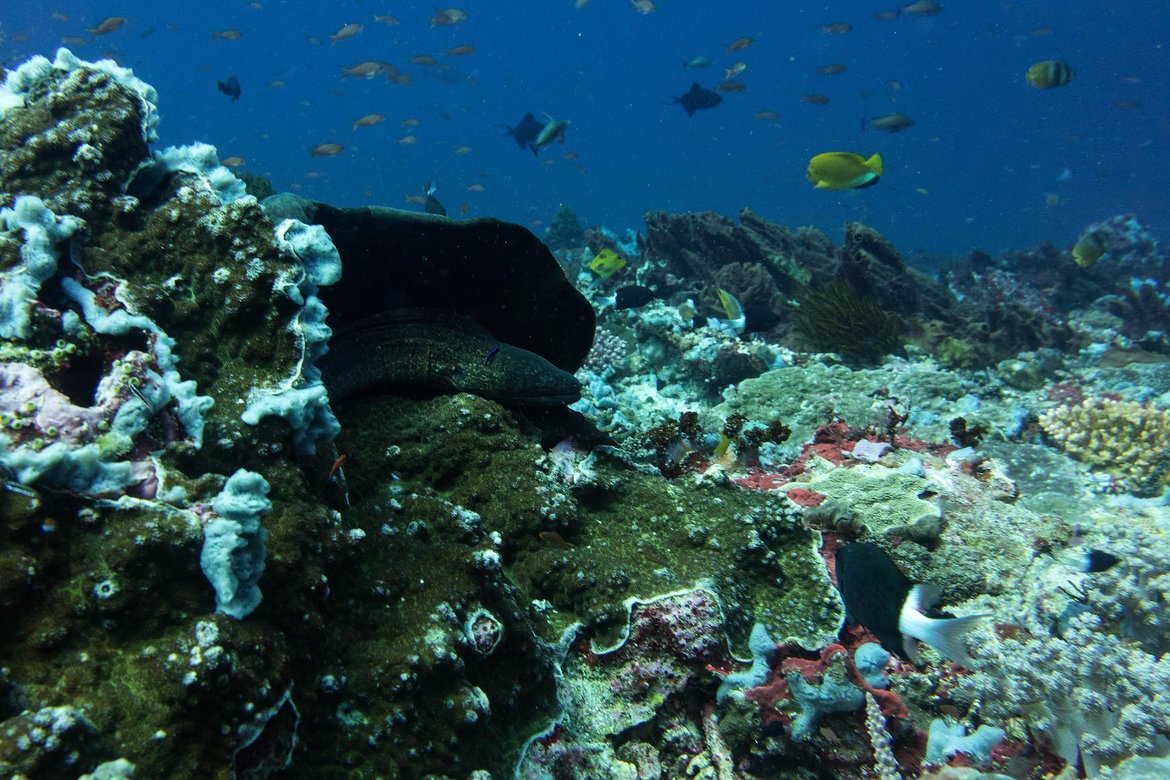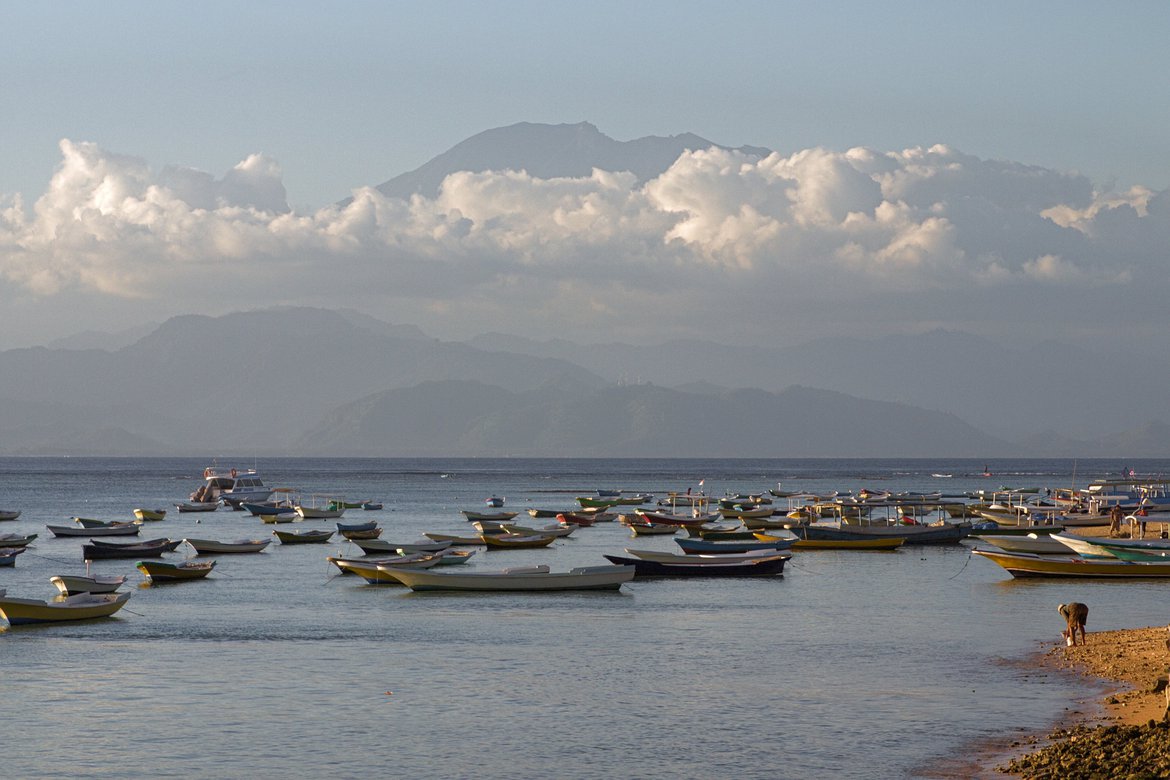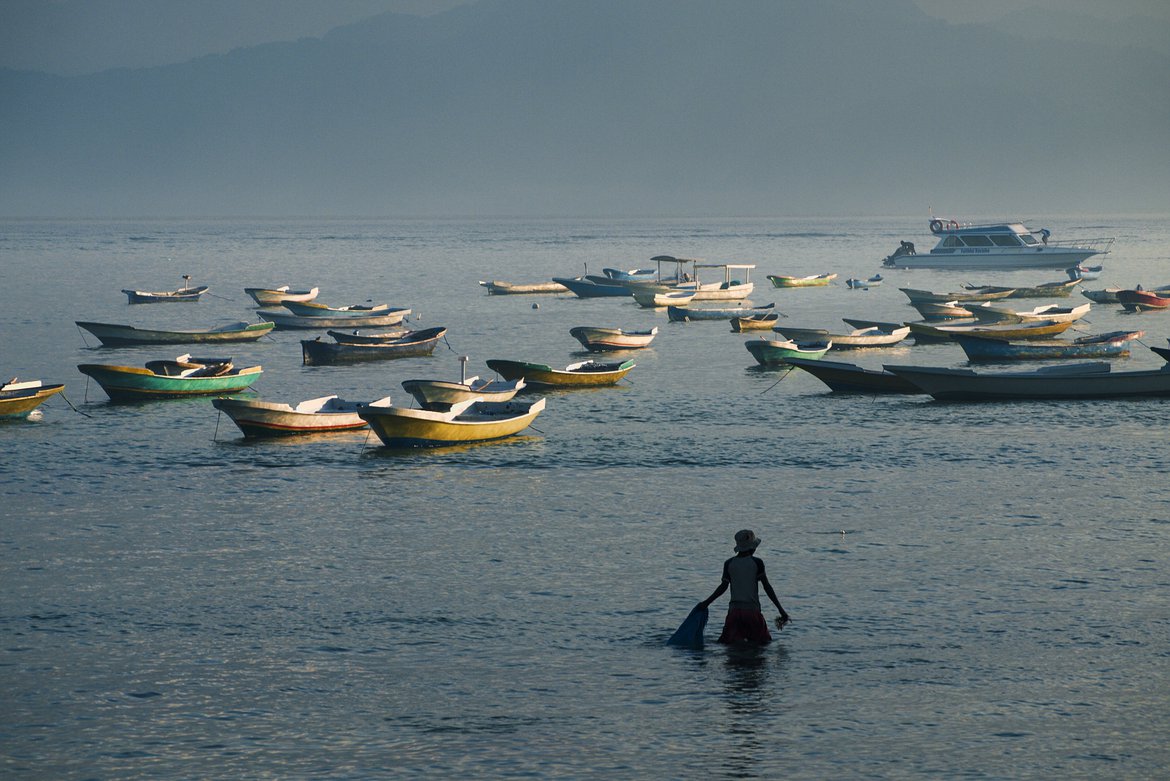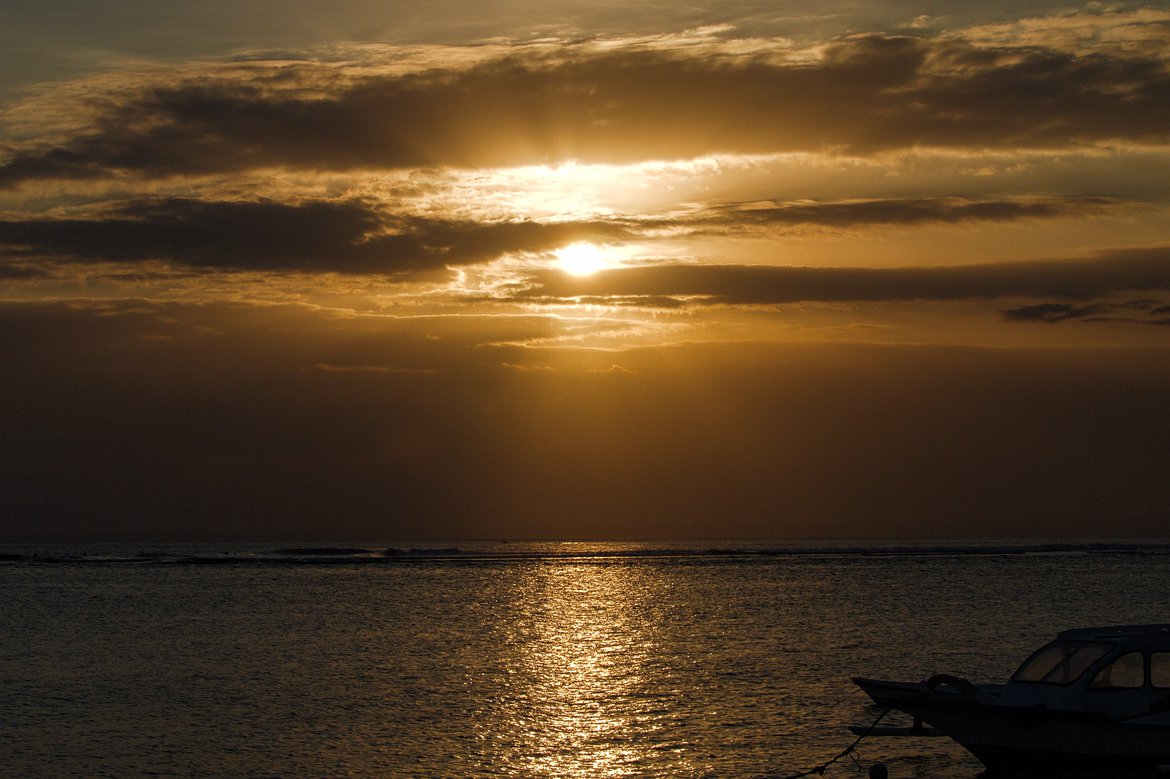The Best Snorkeling in the World
In my experience of the world anyway
Nusa Lembongan is only a few miles off the southwestern coast of Bali, but it might as well be another universe. Here there are few people and no cars, only a few motorbikes that navigate the narrow dirt roads, none more than two meters wide, and your own feet are the dominant way to get around. There’s still tourism, but there’s also a local fishing and seaweed industry.
From Ubud we caught a bus south to Sanur, a beachside town where we thought we might spend a night or two. Unimpressed by the trash strewn beaches and overpriced resorts we went ahead and caught the afternoon boat out to Nusa Lembongan, one of three small islands off the coast of southwest Bali.
The pace here is more my speed. Little seems to happen. People work. People fly kites. People eat. People sit in the shade.
Most of Lembongan’s inhabitants are seaweed farmers. At low tide dozens of farmers make their way down to the shoreline where they load their partially dried seaweed in small outriggers and flat-bottomed boats which they pole out through the shallows to the seaweed fields that line the inland the edge of the reef half a mile from shore. At low tide the seaweed plots are often above the waterline, and even at high tide the expanse of water between the shore and reef is rarely more than a meter deep.
While the farmers are out planting and harvesting seaweed (most of which I’m told ends up in Japan, used as a binding agent in various cosmetics), old women walk the shallows gathering up dropped bits of seaweed or prowl the shoreline plucking worms — which are sold as fish bait back on Bali — from the wet sand.
In the evenings, when the sun dips into the clouds and the air begins to cool, the villagers come down to the beach to fly kites in the evening breeze. Kites are something of an obsession for the Balinese, nearly everyone has a kite and you see dozens littering the sky from any vantage point on the island. There are fewer kites here on Lembongan, but only because there are fewer people here.
These are not the kites you grew up with, small triangular affairs with a bit of ribbon on the tail and a few meters of string. Balinese kites are massive, some with tails hundreds of meters long and they fly them so high the government had to ban them around the Denpasar airport for fear they would clog the engines of 747s. The Balinese are serious about their kites.
Flying kites is fun too, but there’s also a religious aspect stemming from the belief that the Indian god Indra was a kite flying aficionado. Legend holds that Indra taught local farmers how to fly kites and today the Balinese believe the kites to be whispered prayers to the gods, which explains why they fly them so high (well, that and the fact that actually getting a kite 200-300 meters in the air is just cool).
While Lembongan is a relaxing place to pass a few days, or even weeks, the main appeal of the island for most visitors is either the surfing or the snorkeling (and diving, but I’ve never had the patience or desire to learn how to dive, the vast majority of what I find interesting in the ocean is in the first 3 meters of water anyway). I went on two snorkeling trips out of Lembongan, neither of which spent much time at Lembongan’s reefs, opting for the far superior reefs around the two neighboring islands, tiny Nusa Ceningan and the much larger Nusa Penida.
The first stop was a mediocre reef off the dense mangrove forests of Nusa Lembongan. The reef was okay, but the water was murky and crowded with a dozen other boats also dropping snorkelers. After maybe ten minutes in the water the two Australians also on the trip and I asked the boatman if there was anything better to be found. He kept saying drift snorkel, which left us scratching our heads, but we agreed and set off for another ten minute boat ride to the eastern coast of Nusa Penida.

The backside of Nusa Penida is separated from its much smaller neighbor, Nusa Ceningan by a narrow swath of water maybe a kilometer across at its widest. To the south is the open ocean, to the north is the Lombok straight, a very strong current that moves between Bali and Lombok at speeds of up to eight knots. The shallow reef-covered shelfs just off Nusa Penida, have similar currents where the water is suddenly forced through the narrow channel between islands.
Drift snorkeling is a bit like snorkeling in a river. The boat drops you off at one end of the current and you drift for a couple of kilometers down to the end of the current, where the island swings to the west and there’s a small beach where the boat can pick you up again.

In the mean time you drift, like tubing down a river. The shoreline is a limestone cliff, carved inward by the sea. Underwater a shelf slopes off sharply. The first tier is maybe two meters, the second more like four and then finally the shelf drops off into the unknown deep, a rich turquoise blue that is alive with fish. Fish I have previously seen perhaps two or three at a time are swimming in massive schools. Dozens of Moorish Idols, schools of deep purple tangs, so dark they look black until you get up close, parrotfish in clusters, munching on the coral, bright, powder blue tangs, yellow-masked angelfish, countless butterfly fish, wrasses, triggerfish, pufferfish and even bright blue starfish that crawl slowly over the reef. The deep blue depths are filled with myriad triggerfish, angelfish, clownfish and hundreds of others swimming slowly along in the current. There are huge schools of fish that I have only previously seen in books or aquariums back in the States. In fact there are so many fish that just last month a survey done not far from here discovered eight new species of fish.

And I just drift along, occasionally kicking to slow down. Drift snorkeling is like watching fish float by the window of an underwater train. When something catches my eye, like a massive, meter-long lobster tucked back in a small cave of jagged limestone and red brown coral, I kick as hard as I can simply to stay in place and watch.
All too soon it is over. I am too amazed by what is without a doubt the best snorkeling I’ve ever done to even ask if we can do it again. Only some time later, as the boat rounds the corner of Lembongan and begins the treacherous journey back through the seaweed farm shallows, does it occur to me that perhaps we could have asked for another drift. But by then it is too late, and perhaps it would be too greedy, too much all at once, to do it twice in a row.
I am, however, a greedy person, so the next day I signed on to another snorkeling trip, this time out to Manta Point to see the namesake Manta Rays. This time it’s a much longer boat ride all the way around to the southern shores of Nusa Penida. Contrary to what you might think, the waters of Indonesia are not particularly warm, so long boat rides mean a lot of chilly salt spray, and, despite the name, I was not optimistic about our chances of seeing any Manta Rays. But I was wrong.
When we arrive there are a half a dozen of the huge creatures, with their massive rippling wings, circling around a cove, surrounded by shear limestone cliffs. The water is rough, three foot swells blow in from the south, breaking against the cliffs, but in spite of the slight murkiness, it’s impossible to miss the Manta Rays. Mantas are massive things, more than a meter across and at least as long, they don’t so much swim as fly, slowly flapping their wings through the water with a sense of timing and grace that few animals possess. There is something hypnotic about their movements.
Once again I simply floated, bobbing about on the surface of the sea, beaten around a bit by the swell, while the mantas rather gracefully swam through, under and around us, like some proud eagles investigating these curious new onlookers. The rays themselves are so massive, so foreign in shape that it takes some time to come to terms with them. You think at first that they have no eyes. Or no eyes where you might think there should be eyes. Their bodies are black and it is difficult to make out the eyes — which are also black — amidst the darkness of their skin, but then some ray of sunlight breaks through the choppy water and you see the unmistakable glint of a dark eyeball, not at all where you thought it might be and then it dawns on you that they have been watching you all this time, never doubting for a moment where your eyes are. And then the way they have been swimming, the curious pattern of back and forth, becomes clear and you realize these are not simply fish, but something else, something very curious, inquisitive even. They swim at you head on, slowing as they approach, as if they are perhaps near sighted and need a closer look at your floating form, and then they dive about three feet down and slide under you. Once they are clear of you they turn around and repeat the process. Sometimes I dive under them, watching from below as their vast white bellies move overhead, white wings beating slowly, rhythmically through the water.

Mantas are creatures of great grace, they move with poise, like underwater dancers, slowly flapping their way through the depths. If you ever have opportunity to swim with mantas don’t pass it up there is little else in the world like it.
After a half hour or so with the Mantas we head back, stopping off at Crystal Bay, which doesn’t have as many fish as the drift snorkeling area, but has never been fished using dynamite or cyanide — two coral-destroying problems that have ruined many a reef in Asia — and has more coral and intact reef than anywhere else I’ve been.
We spent a mere four days on Lembongan, but in hindsight it was worth much more. In fact, we should probably still be there, since where we went afterward was truly awful, but that’s traveling, you never know what’s up around the corner — sometimes you win, sometimes you lose, you never know until you arrive. I feel lucky to have enjoyed Nusa Lembongan and its neighbors while I had the chance.




7 Comments
Hello from Singapore!
I am planning to visit Nusa Lembongan / Nusa Penida for snorkeling this coming September. Your experience sounds surreal! Would you share where you booked the trip from? Did you do it online or at the island itself? Any tips on what should we look out for when sourcing for packages? :) thank you in advance!
Jie hui-
Unfortunately I don’t remember the name of the guide, but I booked it through the hotel we were staying at, which was the Puri Nusa:
Lembonganhotels.com
For the drift snorkling, just tell them that’s what you want to do, as far as I know where I went was the only place to do that.
The main thing with the mantas is to ask to go to “Manta Point” or sometimes Manta Cove. Pretty much all the guides should know what you’re talking about though.
As for what to watch out for, I suppose there are con artists everywhere, but I didn’t really hear any bad stories or anything while I was there. I think so long as you negotiate everything before hand and are clear on where you want to go (or just what you want to do) you should be fine.
Hope that helps, if you have any other questions, feel free to ask.
Thanks for the great article! I am planning a holiday to Bali and want to try this drift snorkeling. I’m a little confused though, was this done in the narrow water way inbetween Nusa Ceningan and Nusa Penida or on the east side of Nusa Penida?
Thanks again for sharing!
Brian
@Brian-
It’s been a while, but I believe we jumped in about halfway along that narrow water way between Nusa Ceningan and Nusa Penida and then the current pulled us northeast tracing the curve of Nusa Penida.
I can’t really tell the exact location on Google Maps but I know there were some high cliffs so I’m guessing it was around what Google labels as Gamat Bay, probably just to the north of that.
map
Hope that helps, have a great trip.
Thanks for sharing your great snorkelling adventures! I am not a very confident swimmer but love snorkelling. Do you think the drift snorkel would be safe for a relatively novice snorkeller? Ie can you get swamped by waves for extended periods? Thanks, Mary-Anne
@Mary-Anne
There were no real waves where I was, some small chop from wind but that was about it. I would say it’s generally safe for a novice, but of course it would really depend on the exact circumstances, wind, tides, currents, tour operators, etc.
Wear a flotation device and if you’re not completely comfortable with a situation don’t hesitate to stay on the boat.
Hello, I enjoy reading all of your post. I like to write a little comment to support you.
Thoughts?
Please leave a reply:
All comments are moderated, so you won’t see it right away. And please remember Kurt Vonnegut's rule: “god damn it, you’ve got to be kind.” You can use Markdown or HTML to format your comments. The allowed tags are
<b>, <i>, <em>, <strong>, <a>. To create a new paragraph hit return twice.